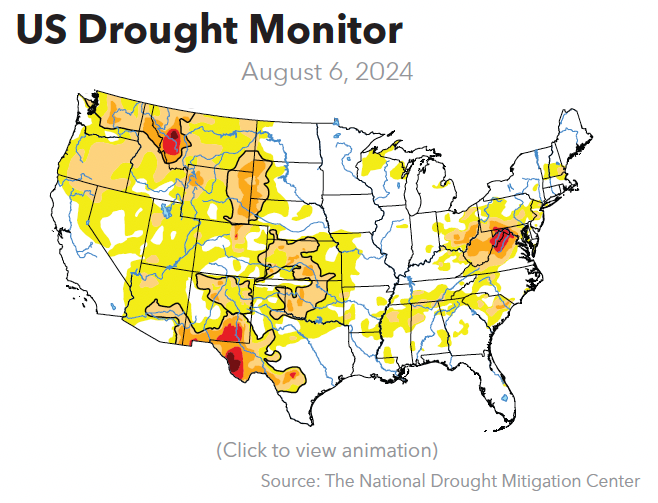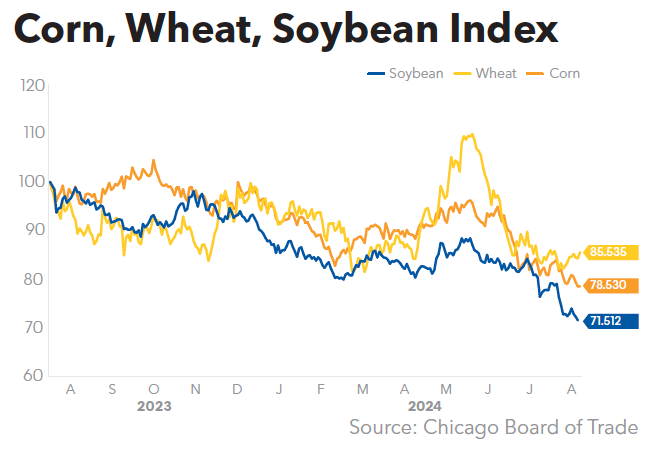Eastern Cornbelt:
Strong storms brought heavy rain, damaging winds, and tornado warnings to northern Illinois and northern Ohio on Aug. 7.
The system prompted a severe thunderstorm warning in the Chicago area early in the day, while northeastern Ohio was hit later with high winds, large hail, and at least one tornado near the town of Parma. Some 400,000 homes and businesses were without power in northeastern Ohio at the peak of the storm.
Indiana avoided most of the several weather, though a cold front dropped temperatures roughly 10 degrees at midweek. Highs across central Indiana were expected to reach the upper-80s and low-90s again by the end of the week, however.
Good or excellent ratings were assigned to 75-81% of the corn and soybeans in Illinois on Aug. 4, compared with 68-70% in Indiana, 63-64% in Ohio, and 60-61% in Michigan.
Western Cornbelt:
A powerful storm spawned several tornadoes in southern Minnesota and northeastern Iowa on Aug. 5, including an EF-1 near Waukon, Iowa, that reached peak wind speeds of 105 mph. A round of showers in central and southern Missouri at midweek brought temperatures down to the low- to mid-80s for the balance of the week.
Fully 70-77% of the regional corn crop and 73-76% of the soybeans were rated as good or excellent on Aug. 4, along with 74% of Nebraska’s sorghum, 76% of Missouri’s rice, and 61% of Missouri’s cotton crop.
Southern Plains:
Rain and cooler temperatures were reported across Kansas and northern Oklahoma as the week progressed, with highs in the 70s and 80s. Heat advisories continued across southern Oklahoma, northern Texas, and New Mexico, however, with highs reaching the triple digits during the week.
Areas of extreme-to-exceptional drought were reported in southern New Mexico and western Texas in early August, with a much broader area of moderate-to-severe drought covering northern New Mexico and a wide swath of Oklahoma and Kansas.
The corn harvest was on in Texas and Kansas, with good or excellent ratings assigned to 35% of the acreage in Texas, 47% in Kansas, and 50% in Colorado. The Kansas soybean crop was 59% good or excellent, while cotton in those two categories totaled 61% of the acreage in Oklahoma, 57% in Kansas, and 32% in Texas. Sorghum rated as good or excellent totaled 60% of the crop in Oklahoma, 45% in Colorado and Kansas, and 41% in Texas.
South Central:
Heat advisories were in effect for southern Arkansas earlier in the week, but cooler weather moved in as the week progressed, with highs in Arkansas and Tennessee topping out in the mid-80s on Aug. 8-9.
High heat continued to blanket much of Louisiana and Mississippi, however, with triple-digit highs reported in both states during the week. New Orleans was bracing for its hottest days of the summer so far on Aug. 7-9.
Crop conditions remained favorable in the region in early August. Good or excellent ratings were assigned to 68% of Kentucky corn crop on Aug. 4, compared with 57% in Tennessee, while soybeans in the good or excellent categories totaled 64% of the acreage in Kentucky and Tennessee, 71% in Mississippi, 73% in Arkansas, and 83% in Louisiana.
Fully 79% of Louisiana’s cotton was rated as good or excellent, compared with 70% in Arkansas, 61% in Tennessee, and 56% in Mississippi. With the rice harvest now 34% complete in Louisiana and 16% in Texas, USDA placed 83% of Louisiana’s crop in the good or excellent categories, along with 76% of the acreage in Arkansas, 64% in Texas, and 57% in Mississippi.
Southeast:
Hurricane Debby brought heavy rain and damaging winds to parts of the Southeast, producing widespread flooding and spawning several deadly tornadoes.
After making landfall in Florida as a Category 1 hurricane on Aug. 5, Debby dumped more than a foot of rain over parts of Florida, Georgia, South Carolina, and North Carolina during the week. Flooding, downed trees, and power outages were also reported in Virginia on Aug. 6. At least six deaths were attributed to the storm.
Debby was expected to move into the Mid-Atlantic region by Friday before sweeping through the Northeast, with forecasts warning of 2-6 inches of rain in parts of Maryland, New York, and New England.
USDA on Aug. 4 assigned good or excellent ratings to 50% of North Carolina’s soybeans and just 21% of the corn, while cotton in those two categories totaled 63% of the crop in North Carolina and Alabama, 66% in Virginia, 67% in Georgia, and 52% in South Carolina. Peanuts rated as good or excellent totaled 91% of Virginia’s crop, compared with 88% in Alabama, 79% in Florida, 70% in Georgia and North Carolina, and 61% in South Carolina.

